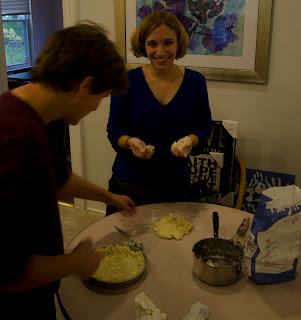 Thanks also to the friends who lent their good judgment for
how long the pudding had to be boiled. More like modern dumplings, the word pudding historically refers to any boiled dish made with flour. Though I was at first
skeptical of the little boiled clumps, they tasted surprisingly wonderful, especially served with the warm cherry sauce poured over the top. They tasted like
little dumplings in sweet cherry sauce.
Thanks also to the friends who lent their good judgment for
how long the pudding had to be boiled. More like modern dumplings, the word pudding historically refers to any boiled dish made with flour. Though I was at first
skeptical of the little boiled clumps, they tasted surprisingly wonderful, especially served with the warm cherry sauce poured over the top. They tasted like
little dumplings in sweet cherry sauce. The Russian Mint Cookies probably required the least
interpretation of any dish I made with this project. The cooking time and temperature were great
to have. The recipe was simple, straightforward, and even edible for my vegan
friends. There was only one ingredient that proved a challenge, baker’s ammonia, which should be available in specialty cooking stores, but as with the sago, I did not have the time to seek it out. I am once again grateful to the
internet for letting me know that baker's ammonia is a leavener which
makes cookies and crackers extra-crisp. Another website advised using equal
parts baking powder and soda as a substitute for baker’s ammonia. I figured I
might as well try it. I think this is part of the reason my cookies rose like
biscuits, but they did have nice crisp shells. The finished product tasted great, the mint flavor was there, but not overwhelming: just right. I would say the mint flavor makes this a great festive cookie for the holiday season. All in all, the day was another delicious success.
The Russian Mint Cookies probably required the least
interpretation of any dish I made with this project. The cooking time and temperature were great
to have. The recipe was simple, straightforward, and even edible for my vegan
friends. There was only one ingredient that proved a challenge, baker’s ammonia, which should be available in specialty cooking stores, but as with the sago, I did not have the time to seek it out. I am once again grateful to the
internet for letting me know that baker's ammonia is a leavener which
makes cookies and crackers extra-crisp. Another website advised using equal
parts baking powder and soda as a substitute for baker’s ammonia. I figured I
might as well try it. I think this is part of the reason my cookies rose like
biscuits, but they did have nice crisp shells. The finished product tasted great, the mint flavor was there, but not overwhelming: just right. I would say the mint flavor makes this a great festive cookie for the holiday season. All in all, the day was another delicious success.
This is technically my last blog entry for this project, but
I may keep up with it more sporadically just for fun. This project has been amazing. It has been a bright spot in my day, teaching me not just about historic
foodways but also a great deal about my friends (and at the risk of sounding
corny) myself. I learned about being brave in the kitchen. I learned about how much easier cooking is nowadays with modern detailed cookbooks. Thanks to all who have helped, taste-tested, kept up with my blog, etc.! I couldn't have done it without you. Thanks also to the Watkinson Library for giving me the chance to try this wonderful project. I advise others to go forth and explore their own "art of imperfection in the kitchen"!















































